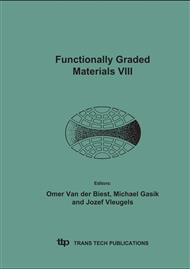p.403
p.409
p.415
p.421
p.429
p.435
p.441
p.447
p.453
Thermo-Mechanical Analysis of RLV Thrust Cell Liners with Homogeneous and Graded Coatings
Abstract:
The Higher-Order Theory for Cylindrical Functionally Graded Materials is employed to investigate the effectiveness of thermal barrier coatings in mitigating deformation mechanisms in thrust cell liners leading to experimentally observed failure modes. The results indicate that under the employed thermo-mechanical loading histories coating thickness has a great impact on temperature and deformation fields within the cooling channel wall of a thrust cell liner, with thicker coatings producing more desirable temperature and deformation fields. Functional grading of metallic substrate and coating materials does not produce improvement in terms of overall thrust cell liner performance. Further, the application of grading is potentially detrimental due to likely roughening of the thrust cell liner wall in the combustion chamber as a result of local deformations around relatively coarse inclusions. The homogenized approach to analyzing the graded coating effectiveness is incapable of capturing these localized effects, leading to erroneous conclusions.
Info:
Periodical:
Pages:
429-434
Citation:
Online since:
August 2005
Authors:
Price:
Сopyright:
© 2005 Trans Tech Publications Ltd. All Rights Reserved
Share:
Citation:


